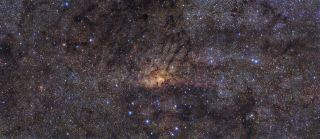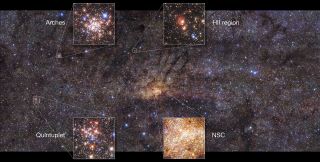Astronomers gazing into the heart of the Milky Way have discovered new clues about our galaxy’s dramatic past.
Using the European Southern Observatory’s Very Large Telescope (VLT) array in Chile’s Atacama Desert, astronomers created a high-resolution image of our galaxy’s center. The new observations revealed a burst of new star formation in the Milky Way’s early years that was so intense, it led to more than 100,000 supernovas, or exploding stars.
“Our unprecedented survey of a large part of the Galactic centre has given us detailed insights into the formation process of stars in this region of the Milky Way,” Rainer Schödel, a researcher with the Institute of Astrophysics of Andalusia (IAA) in Granada, Spain, who led the observations, said in a statement.
Video: See the Milky Way’s Central Region in Incredible VLT View
Related: Our Milky Way Galaxy’s Core Revealed (Photos)


“Contrary to what had been accepted up to now, we found that the formation of stars has not been continuous,” Francisco Nogueras-Lara, who led two new studies based on these observations of the Milky Way central region at IAA, said in the same statement.
One of the studies, which was published today (Dec. 16) in the journal Nature Astronomy, found that about 80% of the stars in the core of the Milky Way formed between 8 billion and 13.5 billion years ago. For comparison, scientists believe that the Milky Way galaxy is about 13.6 billion years old.
“This initial period of star formation was followed by about six billion years during which very few stars were born,” ESO officials said in the statement. “This was brought to an end by an intense burst of star formation around one billion years ago when, over a period of less than 100 million years, stars with a combined mass possibly as high as a few tens of million suns formed in this central region.”
Video: Milky Way Galaxy’s Central Region – Very Large Telescope Zoom-In
“The conditions in the studied region during this burst of activity must have resembled those in ‘starburst’ galaxies, which form stars at rates of more than 100 solar masses per year,” said Nogueras-Lara, who is now based at the Max Planck Institute for Astronomy in Heidelberg, Germany.
Researchers captured these images using an instrument on VLT called HAWK-I, a wide-field imager that observes the sky in near-infrared wavelengths, which allows it to “see” through dense clouds of interstellar dust and gas. The HAWK-I instrument allowed researchers to capture this stunning new view of the Milky Way, which was first published in October in the journal Astronomy & Astrophysics.
Email Hanneke Weitering at hweitering@space.com or follow her @hannekescience. Follow us on Twitter @Spacedotcom and on Facebook.






